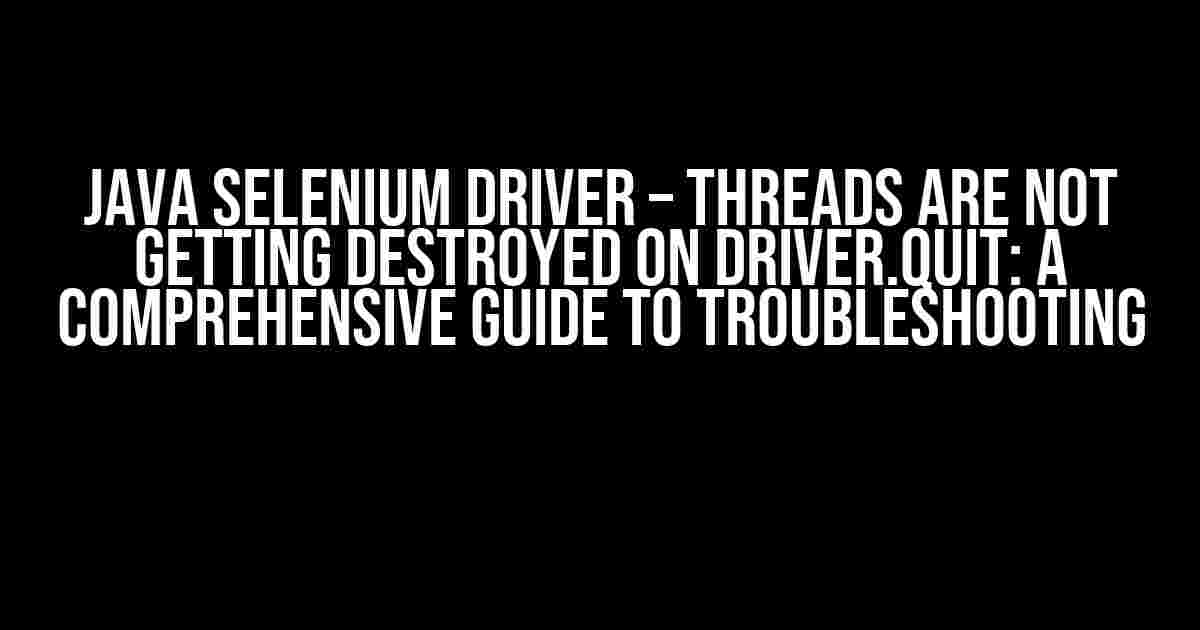If you’re working with Java Selenium, you might have encountered the frustrating issue of threads not getting destroyed when you call driver.quit(). This issue can lead to resource leaks, slow performance, and even crashes. In this article, we’ll dive deep into the reasons behind this problem, explore the symptoms, and provide you with step-by-step solutions to resolve it.
Understanding the Problem
When you create a Selenium driver instance in Java, it spawns a new browser process and creates multiple threads to manage the browser’s interactions. These threads are essential for executing your test scripts, but they can become a liability if not properly handled.
The driver.quit() method is supposed to release all resources associated with the driver, including the threads. However, in some cases, the threads might not get destroyed, leading to issues like:
- Resource leaks: Unreleased threads can consume system resources, causing performance degradation and even crashes.
- Memory leaks: Threads that don’t get destroyed can hold onto memory, leading to out-of-memory errors and slowing down your system.
- Unpredictable behavior: Undestroyed threads can cause unpredictable behavior in your tests, making it difficult to diagnose issues.
Causes of the Issue
There are several reasons why threads might not get destroyed on driver.quit(). Let’s explore some common causes:
1. Incorrect Driver Instantiation
One common mistake is instantiating the driver in a wrong way. For example:
WebDriver driver = new ChromeDriver();
driver = new FirefoxDriver(); // This will not destroy the previous ChromeDriver instance
In this example, the ChromeDriver instance will not get destroyed, as a new FirefoxDriver instance is created without quitting the previous one.
2. Multiple Driver Instances
Having multiple driver instances can lead to undestroyed threads. For instance:
WebDriver driver1 = new ChromeDriver();
WebDriver driver2 = new FirefoxDriver();
driver1.quit(); // This will not destroy the FirefoxDriver instance
In this case, the FirefoxDriver instance will not get destroyed when you call driver1.quit().
3. Thread Interference
If you’re using multiple threads to execute tests in parallel, you might encounter issues with thread interference. For example:
ExecutorService executor = Executors.newFixedThreadPool(5);
WebDriver driver = new ChromeDriver();
executor.submit(() -> {
driver.get("https://www.google.com");
// Some test logic here
});
executor.submit(() -> {
driver.quit(); // This might not destroy the threads correctly
});
In this scenario, the threads might not get destroyed correctly, leading to resource leaks and performance issues.
Solutions to the Problem
Now that we’ve explored the causes, let’s dive into the solutions:
1. Correct Driver Instantiation
Make sure to instantiate the driver correctly, using a single instance per test or per-thread:
WebDriver driver = new ChromeDriver();
// Use the driver instance for your test logic
driver.quit(); // This will destroy the driver instance correctly
2. Use a Singleton Pattern
Create a singleton class to manage the driver instance. This ensures that only one instance is created and destroyed:
public class DriverManager {
private static WebDriver driver;
public static WebDriver getDriver() {
if (driver == null) {
driver = new ChromeDriver();
}
return driver;
}
public static void quitDriver() {
if (driver != null) {
driver.quit();
driver = null;
}
}
}
Then, use the singleton class in your tests:
WebDriver driver = DriverManager.getDriver();
// Use the driver instance for your test logic
DriverManager.quitDriver(); // This will destroy the driver instance correctly
3. Use a ThreadLocal Driver
When using multiple threads, create a ThreadLocal driver instance to ensure each thread has its own driver:
ThreadLocal<WebDriver> threadLocalDriver = new ThreadLocal<>();
threadLocalDriver.set(new ChromeDriver());
// Use the thread-local driver instance for your test logic
threadLocalDriver.get().quit(); // This will destroy the driver instance correctly
4. Implement a Shutdown Hook
Create a shutdown hook to ensure that the driver is quit when the JVM exits:
Runtime.getRuntime().addShutdownHook(new Thread(() -> {
WebDriver driver = DriverManager.getDriver();
if (driver != null) {
driver.quit();
}
}));
5. Monitor and Kill Zombie Processes
In some cases, the browser process might not get destroyed even after calling driver.quit(). To handle this, you can use a utility like ProcessHandle to monitor and kill zombie processes:
import java.lang.ProcessHandle;
public class ProcessKiller {
public static void killZombieProcesses() {
ProcessHandle.allProcesses()
.filter(process -> process.info().command().orElse("").contains("chromedriver"))
.forEach(process -> process.destroy());
}
}
Then, call the killZombieProcesses() method in your test teardown or in a shutdown hook:
@AfterClass
public static void tearDown() {
WebDriver driver = DriverManager.getDriver();
if (driver != null) {
driver.quit();
}
ProcessKiller.killZombieProcesses();
}
Best Practices
To avoid the “threads not getting destroyed on driver.quit” issue, follow these best practices:
- Use a single driver instance per test or per-thread.
- Implement a singleton pattern or a ThreadLocal driver instance.
- Use a shutdown hook to ensure the driver is quit when the JVM exits.
- Monitor and kill zombie processes using a utility like
ProcessHandle. - Avoid creating multiple driver instances or reusing an existing instance.
- Call
driver.quit()in a finally block or in a shutdown hook to ensure it’s called even when an exception occurs.
Conclusion
In this article, we’ve explored the reasons behind the “threads not getting destroyed on driver.quit” issue in Java Selenium and provided you with step-by-step solutions to resolve it. By following the best practices and implementing the solutions, you can ensure that your tests run smoothly, and your system resources are not wasted.
Remember, a well-managed Selenium driver instance is key to avoiding resource leaks, memory leaks, and performance issues. By taking control of your driver’s lifecycle, you can write more efficient and reliable tests.
| Keyword | Description |
|---|---|
| Java Selenium | A Java-based testing framework for automating web browsers. |
| driver.quit() | A method to release all resources associated with the driver. |
| Threads | Lightweight processes that execute tasks concurrently. |
| Singleton Pattern | A design pattern to ensure a single instance of a class is created. |
| ThreadLocal | A class to create thread-local variables that are unique to each thread. |
| Shutdown Hook | A mechanism to execute code when the JVM exits. |
By following the guidelines and solutions outlined in this article, you’ll be well-equipped to tackle the “threads not getting destroyed on driver.quit” issue and write more efficient and reliable tests with Java Selenium.
Frequently Asked Question
Q1: Why do my threads refuse to die after calling driver.quit()?
This might happen if your test is using multiple threads or parallel execution. When you call driver.quit(), it only closes the browser instance, not the underlying thread. You need to explicitly join or interrupt the thread to ensure it’s terminated properly.
Q2: How do I ensure all threads are closed after test execution?
Use a ThreadFactory to create and manage your threads. This allows you to keep track of active threads and invoke Thread#join() or Thread#interrupt() as needed. You can also leverage the ExecutorService framework to manage thread pools and shutdown them after test execution.
Q3: Can I use a try-finally block to ensure driver.quit() is always called?
Yes, a try-finally block is an excellent way to guarantee that driver.quit() is called, even if an exception occurs. This ensures the browser instance is closed, and you can then proceed to join or interrupt the underlying thread as needed.
Q4: What’s the best way to handle thread interruption in Selenium tests?
When interrupting a thread, use Thread#interrupt() instead of Thread#stop(), which is deprecated. Then, use a try-catch block to catch InterruptedException and re-throw it as a RuntimeException. This ensures the thread is properly terminated and allows the test to fail accordingly.
Q5: Are there any best practices for writing thread-safe Selenium tests?
Yes, always use thread-safe WebDriver instances, avoid sharing WebDriver instances between threads, and use synchronization mechanisms like locks or semaphores to ensure thread safety. Also, consider using parallel testing frameworks like TestNG or JUnit’s Parallel Computing to simplify thread management.



